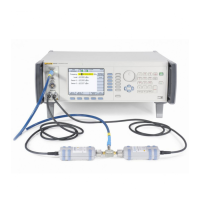Performance Tests
Performance Test 3
3-29
Table 3-13. 50 Ω Leveling Head,-Low Level Accuracy Test Points Part B (96040A and 96270A)
Part Frequency Amplitude Reading
P
out
Tolerance
B
100 kHz
-75 dBm Reference Reference
-85 dBm
P
rel
±0. 50 dB
10 MHz
-75 dBm Reference Reference
-85 dBm
P
rel
±0.30 dB
-95 dBm
P
rel
±0.70 dB
100 MHz
-75 dBm Reference Reference
-85 dBm
P
rel
±0.30 dB
-95 dBm
P
rel
±0.70 dB
300 MHz
-75 dBm
P-
37
Reference
-85 dBm
P
rel
±0.50 dB
-95 dBm
P
rel
±1.50 dB
1.4 GHz
-75 dBm Reference Reference
-85 dBm
P
rel
±1.00 dB
-95 dBm
P
rel
±1.50 dB
3 GHz
-75 dBm
P-
37
Reference
-85 dBm
P
rel
±1.00 dB
4 GHz
-75 dBm Reference Reference
-85 dBm
P
rel
±1.00 dB
Note
The above procedure and test points listed in Table 3-12 verify the
performance of all the level control and attenuation circuits that
determine level accuracy throughout the entire amplitude range,
avoiding the need to make difficult precision level measurements at
extremely low levels below -95 dBm. However, the following optional
ultra-low-level measurement procedure is provided for users
choosing to verify the lower level outputs directly.
Optional Ultra-Low Level Test Points (steps 37-43)
If required, use the subsequent optional procedure to verify the absolute level
accuracy of the UUT below -95 dBm.
Note
Ultra-low-level measurements are made relative to a level previously
measured with the Measuring Receiver. Measurements made
at -75 dBm are used as reference points to provide the required UUT
hardware configuration for the subsequent tests. The value of the
output level at -75 dBm measured in steps 28 through 36 above will
be used as references in the subsequent procedure, identified as
P
-75
for each test frequency. It is important that the correct sequence
is followed as described.
Making these precision ultra-low-level measurements requires
appropriate choice of Measuring Receiver settings to provide
adequate linearity, noise floor, and reading repeatability throughout
the amplitude range required. For any given frequency the
Measuring Receiver the settings must be maintained for all
amplitudes at that frequency after establishing the reference point. In
particular, receiver attenuator, reference level, and resolution
bandwidth settings must not change.

